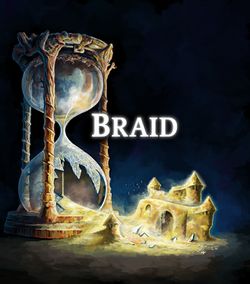
| Braid | |
|---|---|
| Developer(s) | Number None |
| Publisher(s) | Number None, Microsoft Game Studios |
| Year released | 2008 |
| System(s) | Xbox 360, Windows, macOS, PlayStation 3, Linux |
| Designer(s) | Jonathan Blow |
|---|---|
| Genre(s) | Platform, Puzzle |
| Modes | Single player |
| Latest version | 1.014 (Windows) 1.5 (Mac OS X) |
| Rating(s) |
| Braid, Anniversary Edition | |
|---|---|
| Developer(s) | Number None |
| Publisher(s) | Number None |
| Year released | 2024 |
| System(s) | PlayStation 4, PlayStation 5, Xbox One, Xbox Series X, Windows |
Braid is a platform and puzzle video game developed by independent software developer Jonathan Blow (Number None). The game was released on August 6, 2008 for the Xbox 360's Xbox Live Arcade service. A Microsoft Windows version was released on April 10, 2009. Hothead Games ported and released the game to macOS on May 20, 2009 and the PlayStation Network on November 12, 2009. On December 14, 2010, a Linux version was released as part of the Humble Indie Bundle 2.
Blow designed the game as a personal critique of contemporary trends in game development. He funded the three-year project with his own money. Webcomic artist David Hellman drew the artwork, which underwent several iterations until it satisfied Blow's vision. A preliminary version of Braid without the final artwork won the "Innovation in Game Design" award at the 2006 Independent Games Festival; the final version received additional accolades.
On April 30, 2024 Braid, Anniversary Edition was released. It includes updated graphics, and developer commentary.
-
Title Screen
-
Xbox Live Arcade Cover
-
Steam Cover
-
Game logo
Story[edit]
At its most basic level, the story describes the protagonist Tim's attempt to rescue a princess from a monster. Clues embedded in the plot have led to multiple metaphorical interpretations of the plot, such as a tale of a faltering relationship or the development of the atomic bomb.
Gameplay[edit]
The game features traditional aspects of the platform genre; the player runs, jumps, and climbs through a linear set of stages while solving puzzles and defeating enemies. The player may also manipulate time, such as by allowing actions to be "rewound", even after death, or by creating a shadow doppelganger to repeat actions previously performed. Using these abilities, the player progresses the story by finding and assembling jigsaw puzzle pieces.



